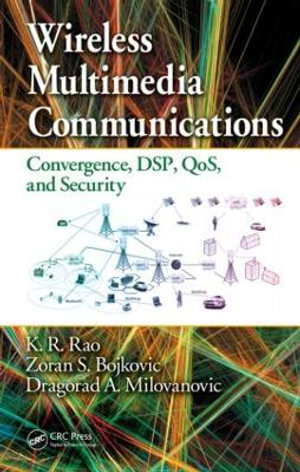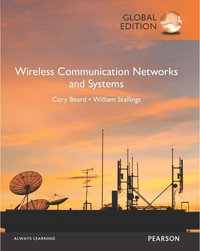
Instant online reading.
Don't wait for delivery!
Go digital and save!
Wireless Multimedia Communications
Convergence, DSP, QoS, and Security
By: agorad A. Milovanovic, Zoran S. Bojkovic, K.R. Rao
Hardcover | 21 November 2008 | Edition Number 1
At a Glance
344 Pages
24.2 x 16.7 x 2.5
Hardcover
RRP $336.00
$279.40
17%OFF
or 4 interest-free payments of $69.85 with
orAvailable for Backorder. We will order this from our supplier however there isn't a current ETA.
Take Maximum Advantage of Wireless Technology and Exploit Potential Advances
With the rapid evolution of multimedia communications, engineers and other professionals are generally forced to hoard a plethora of different texts and journals to maintain a solid grasp on essential ideas and techniques in the field. Wireless Multimedia Communications provides researchers and students with a primary reference to help readers take maximum advantage of current systems and uncover opportunities to propose new and novel protocols, applications, and services.
Extract the Essentials of System Design, Analysis, Implementation
A complete technical reference, the text condenses the essential topics of core wireless multimedia communication technologies, convergence, QoS, and security that apply to everything from networking to communications systems, signal processing, and security. From extensive existing literature, the authors distill the central tenets and primary methods of analysis, design, and implementation, to reflect the latest technologies and architectural concepts. The book addresses emerging challenges to inform the system standardization process and help engineers combat the high error rates and stringent delay constraints that remain a significant challenge to various applications and services.
Keep Pace with Detailed Techniques to Optimize Technology
The authors identify causes of information loss in point-to-point signal transmission through wireless channels, and then they discuss techniques to minimize that loss. They use examples that illustrate the differences in implementing various systems, ranging from cellular voice telephony to wireless Internet access. Each chapter has been carefully organized with the latest information to serve dual purposes as an easy-to-reference guide for professionals and as a principal text for senior-level university students.
| Preface | p. xi |
| Acknowledgments | p. xv |
| List of Acronyms | p. xvii |
| Overview | p. xxix |
| Introduction to Wireless Networking | p. 1 |
| Evolution of Mobile Networks | p. 2 |
| High-Speed Circuit-Switched Data | p. 3 |
| i-Mode Services | p. 3 |
| GPRS and EDGE for GSM Evolution | p. 4 |
| Third Generation Systems History | p. 6 |
| IMT-2000 | p. 7 |
| GSM Evolution to UMTS | p. 11 |
| IMT-2000 Standardization Process | p. 12 |
| Evolving Wireless Multimedia Networks | p. 13 |
| Multimedia over Wireless | p. 17 |
| Multimedia Services in WLAN | p. 19 |
| Ad Hoc Networks and Multimedia Services in WPANs | p. 20 |
| Multimedia Services over 3G Networks | p. 21 |
| Hybrid Multimedia Networks | p. 22 |
| Users' Perspectives | p. 23 |
| Convergence Technologies | p. 27 |
| Introduction | p. 27 |
| Next Generation Network Architecture | p. 29 |
| Convergence Technologies for 3G Networks | p. 34 |
| Technologies for 3G Cellular Wireless Communication Systems | p. 36 |
| 3G Mobile Communication Systems and WCDMA | p. 39 |
| High-Speed Data Access | p. 40 |
| High-Speed Downlink Packet Access (HSDPA) | p. 40 |
| Enhanced Uplink | p. 43 |
| Multiple Broadcast Multicast Services | p. 44 |
| 3G Personal Communication Services Technologies | p. 45 |
| Challenges in the Migration to 4G Mobile System | p. 46 |
| Concluding Remarks | p. 51 |
| Wireless Video | p. 53 |
| Introduction | p. 53 |
| Video over Wireless | p. 54 |
| Energy-Efficient Wireless Communication System | p. 57 |
| Streaming Video over Wireless: Rate Control | p. 59 |
| Content Delivery Technologies | p. 60 |
| Layer 1/2 Technologies | p. 60 |
| Technologies above Layer 2 | p. 61 |
| H.263/AVC Standard in Wireless Video Environment | p. 63 |
| Video Coding and Decoding Algorithms | p. 63 |
| Network Integration | p. 65 |
| Compression Efficiency | p. 66 |
| Error Resilience | p. 66 |
| Bit Rate Adaptivity | p. 68 |
| Concluding Remarks | p. 69 |
| Wireless Multimedia Services and Applications | p. 71 |
| Introduction | p. 71 |
| Real-Time IP Multimedia Services in UMTS | p. 74 |
| IP Multimedia Services | p. 74 |
| UMTS Releases | p. 76 |
| Evolution from Short to Multimedia Messaging Services | p. 77 |
| Internet Protocol Multimedia Subsystem | p. 79 |
| IMS Conception | p. 80 |
| IP Multimedia Subsystem Architecture | p. 82 |
| Multimedia Services Accessing | p. 85 |
| IMS in the Network Environment | p. 85 |
| Web Services in IMS | p. 87 |
| Service Delivery Platform | p. 88 |
| Extended IMS Architecture | p. 88 |
| Policy Control in IMS | p. 90 |
| IMS Standardization Effort | p. 92 |
| Location-Based Services | p. 93 |
| Requirements for LBS Delivery | p. 94 |
| LBS System | p. 96 |
| Concluding Remarks | p. 97 |
| Wireless Networking Standards (WLAN, WPAN, WMAN, WWAN) | p. 99 |
| Introduction | p. 99 |
| Standardization Process in IEEE 802 | p. 102 |
| Wireless Local Area Networks (WLAN) | p. 102 |
| Overview of the IEEE 802.11 Standardization | p. 103 |
| IEEE 802.11a | p. 104 |
| IEEE 802.11b | p. 104 |
| IEEE 802.11c | p. 104 |
| IEEE 802.11d | p. 104 |
| IEEE 802.11e | p. 105 |
| IEEE 802.11f | p. 105 |
| IEEE 802.11g | p. 106 |
| IEEE 802.11h | p. 106 |
| The IEEE 802.11 MAC Layer | p. 106 |
| IEEE 802.11i | p. 107 |
| IEEE 802.11j | p. 107 |
| IEEE 802.11k | p. 107 |
| IEEE 802.11m | p. 107 |
| IEEE 802.11n | p. 108 |
| IEEE 802.11 General Architecture | p. 108 |
| Wireless LAN Link Layer Standards | p. 111 |
| Wireless ATM LAN | p. 113 |
| Wireless ATM Working Group | p. 114 |
| ETSI BRAN HIPERLAN Standard | p. 115 |
| HIPERLAN2 System | p. 117 |
| Overview of Physical Layers of HIPERLAN2 and IEEE 802.11a | p. 121 |
| Infrared Standards | p. 122 |
| Interconnection for Wireless Networks | p. 125 |
| Techniques for Diffuse Links: Spread Spectrum | p. 125 |
| Wireless Personal Area Networks | p. 126 |
| WPAN Devices | p. 127 |
| Bluetooth | p. 129 |
| Ultrawideband Communications | p. 132 |
| Advantages of UWB | p. 134 |
| UWB Regulation | p. 135 |
| IEEE 802.15.3a | p. 136 |
| IEEE 802.15.4 | p. 136 |
| UWB Medium Access Control | p. 136 |
| Wireless Metropolitan Area Networks | p. 140 |
| IEEE 802.16 Network Management | p. 142 |
| Frequency Range of IEEE 802.16 | p. 143 |
| IEEE 802.16 Medium Access Control Protocol | p. 143 |
| IEEE 802.16 OFDM PHY Layer | p. 146 |
| Wireless Wide Area Networks | p. 147 |
| Mission, Scope, and Purpose | p. 149 |
| Technical Aspects Related to IEEE 802.20 System | p. 150 |
| Air Interface Characteristics | p. 152 |
| IEEE 802.20 System Architecture | p. 154 |
| Standard IEEE 802.20 Relationship to 802.16e and 3G | p. 155 |
| IEEE 802.20 Wireless Mesh Networks | p. 157 |
| IEEE 802.20-Based Architecture: An Example | p. 159 |
| H.264 Video Transmission over IEEE 802.11 Wireless LAN Networks | p. 160 |
| H.264 Overview | p. 160 |
| Distributed Coordination Function | p. 162 |
| Video Communication over WLAN | p. 162 |
| Proposals for Future Work on H.264 Standard | p. 164 |
| Concluding Remarks | p. 165 |
| Advances in Wireless Video | p. 167 |
| Introduction | p. 167 |
| Error Robustness Support Using H.264/AVC | p. 169 |
| Error Control | p. 169 |
| Error Concealment | p. 170 |
| Limitation of Error Propagation | p. 171 |
| Error Resilience Video Transcoding | p. 172 |
| History | p. 172 |
| Error Resilience Transcoder | p. 174 |
| Error Resilience Transcoding Techniques | p. 179 |
| Energy-Efficient Wireless Video | p. 180 |
| Energy-Efficient Video Coding | p. 181 |
| Multipath Video Transport | p. 182 |
| General Architecture | p. 183 |
| Concluding Remarks | p. 184 |
| Cross-Layer Wireless Multimedia | p. 187 |
| Introduction | p. 187 |
| Cross-Layer Design | p. 190 |
| Modeling System | p. 190 |
| Architecture for Video Delivery over Wireless Channel | p. 192 |
| Cross-Layer Optimization | p. 196 |
| Cross-Layer Wireless Transmission | p. 197 |
| Optimization Strategies | p. 197 |
| Cross-Layer Solutions | p. 199 |
| Cross-Layer Design Approaches for Resource Allocation and Management | p. 200 |
| CDMA Resource Allocation | p. 200 |
| Channel-Aware Scheduling | p. 202 |
| TCP over CDMA Wireless Links | p. 203 |
| Joint Video Source/Channel Coding and Power Allocation | p. 203 |
| Ability of a Video Codec to Adjust Its Source Coding Rates | p. 204 |
| Integrated Voice-Data | p. 204 |
| OFDM-Based Wireless Networks | p. 206 |
| Concluding Remarks | p. 208 |
| Mobile Internet | p. 211 |
| Introduction | p. 211 |
| Related Protocols | p. 212 |
| Traditional Mobility Management | p. 213 |
| IP Mobility Protocol Classification | p. 214 |
| Global Mobility Protocols | p. 215 |
| Global Mobility/Macromobility Protocols | p. 218 |
| Macromobility Protocols | p. 219 |
| Macro/Micromobility Protocols | p. 219 |
| IP Mobility and Wireless Networks | p. 220 |
| Wireless LANs | p. 220 |
| Wireless WANs | p. 221 |
| Cellular and Heterogeneous Mobile Networks | p. 222 |
| Quantitative Analysis of Enhanced Mobile Internet | p. 224 |
| Scalable Application-Layer Mobility Protocol | p. 225 |
| Session Initiation Protocol | p. 226 |
| P2P Overlay Networking | p. 226 |
| Scalable Application-Layer Mobility Architecture | p. 227 |
| Mobility and QoS | p. 228 |
| Seamless Mobility Services: A Network Architecture | p. 232 |
| Concluding Remarks | p. 233 |
| Evolution toward 4G Networks | p. 235 |
| Introduction | p. 235 |
| Migration to 4G Mobile Systems | p. 237 |
| Beyond 3G and toward 4G Networks | p. 239 |
| WAN and WLAN Integration | p. 239 |
| Ad Hoc Networking | p. 239 |
| Infrastructure-Based Access Technologies | p. 241 |
| UWB and S-T Coding | p. 242 |
| Location Awareness | p. 242 |
| 4G Technologies from the User's Point of View | p. 242 |
| User Scenarios | p. 244 |
| User Friendliness | p. 245 |
| User Personalization | p. 245 |
| Terminal and Network Heterogeneity | p. 245 |
| Service Personalization | p. 247 |
| Heterogeneous Systems Integration | p. 247 |
| Heterogeneous Services | p. 247 |
| Interworking Devices | p. 249 |
| All-IP Network | p. 249 |
| Network Composition Procedure | p. 250 |
| All-IP 4G Network Architecture | p. 253 |
| QoS Issues for 4G Networks | p. 254 |
| Providing Quality of Service | p. 256 |
| End-to-End QoS Support | p. 258 |
| Security in 4G Networks | p. 259 |
| Infrastructure Security for Future Mobile Networks | p. 259 |
| Infrastructure Security Definition | p. 261 |
| Infrastructure Security Requirements | p. 262 |
| Secure Handover between Heterogeneous Networks | p. 263 |
| Security Context | p. 264 |
| Security Context in Handover | p. 265 |
| Network Operators' Security Requirements | p. 265 |
| Requirements from Users' Perspective | p. 266 |
| Requirements from the Network's Perspective | p. 267 |
| Requirements from the Service Providers' Perspective | p. 268 |
| Concluding Remarks | p. 269 |
| References | p. 271 |
| Index | p. 289 |
| Table of Contents provided by Ingram. All Rights Reserved. |
ISBN: 9780849385827
ISBN-10: 0849385822
Published: 21st November 2008
Format: Hardcover
Language: English
Number of Pages: 344
Audience: College, Tertiary and University
Publisher: Taylor & Francis Inc
Country of Publication: GB
Edition Number: 1
Dimensions (cm): 24.2 x 16.7 x 2.5
Weight (kg): 0.61
Shipping
| Standard Shipping | Express Shipping | |
|---|---|---|
| Metro postcodes: | $9.99 | $14.95 |
| Regional postcodes: | $9.99 | $14.95 |
| Rural postcodes: | $9.99 | $14.95 |
How to return your order
At Booktopia, we offer hassle-free returns in accordance with our returns policy. If you wish to return an item, please get in touch with Booktopia Customer Care.
Additional postage charges may be applicable.
Defective items
If there is a problem with any of the items received for your order then the Booktopia Customer Care team is ready to assist you.
For more info please visit our Help Centre.
You Can Find This Book In

Convergence of Deep Learning and Artificial Intelligence in Internet of Things
Future Generation Information Systems
Paperback
RRP $103.00
$87.25
OFF






















